In order for your HR teams to be able to properly carry out their vital responsibility of recruiting, managing, and preserving a highly skilled, talented, and satisfied workforce, the right HRIS is a total game-changer by streamlining and automating HR processes and boosting productivity.
As an HR manager, you’re responsible for shaping, managing, and maintaining your workforce.
There’s a lot to do: from motivating staff and processing payroll to handling an endless flow of paperwork and managing time-off requests, you may start feeling burned out. Fortunately, human resource information systems (HRIS) can be just the tool you need to streamline and simplify your daily processes.
We’ve lined up our top picks of the best HRIS systems to give you a clear picture of what’s out there and help you find one that best suits your company’s needs and budget.
Our Top Picks
-
Best all-in-one HRIS system
-
Good for midsized businesses
-

Good for compensation management
Why trust us?
Our team of unbiased software reviewers follows strict editorial guidelines, and our methodology is clear and open to everyone.
See our complete methodology
41
Tools considered
28
Tools reviewed
11
Best tools chosen
What to Look For in a HRIS System
When looking for a good HRIS, keep an eye out for the following key aspects and features:
- Customizability: The HRIS system should be customizable to suit your team structures.
- Employee database: The best HRIS serves as a centralized database of your entire workforce and allows you to update and manage employee information and documentation.
- Self-service option: Your managers and employees can access their own personal information and keep their records up to date.
- Time and attendance management: You can track and manage attendance and your employees can log work hours, submit time-off requests, and review their timesheets.
- Performance management: The HRIS software should give you valuable insights into your employees’ performance and helps you maintain a high-performance company culture.
- Onboarding and training: You can easily create and manage employee training and onboarding processes for new hires.
- Payroll and benefits administration: The HRIS software system should calculate payroll and record your employees’ gross and net pay, deductions, benefits, and tax liabilities.
- Data analytics: You can filter and get a clear view of any data in the system.
- Applicant tracking system (ATS): The best HRIS systems streamline the recruitment process and centralize information about job candidates, job postings, and interviews.
- Price: It is cost-friendly and suits your budget.
- Support: It comes with good customer support to help you with any issues.
The 11 Best HRIS Systems of 2025
-
Connecteam — Best all-in-one HRIS system
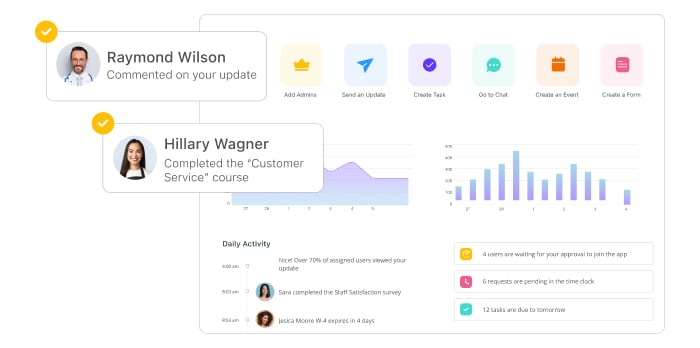
With an HR and People Management Hub, Connecteam has all the features you need to manage all HR-related information. From scheduling and time-off management to onboarding, training, and employee engagement, Connecteam’s all-in-one HRIS software helps companies better manage their teams.
Let’s take a closer look at the specifics:
Document storage feature stores important employee documents and information
Connecteam’s document storage feature allows you to upload and store important HR forms and documents, like compliance certificates, tax documents, applications, and health forms. Employees can fill them out and submit them directly from their smartphones, streamlining the paperwork process.
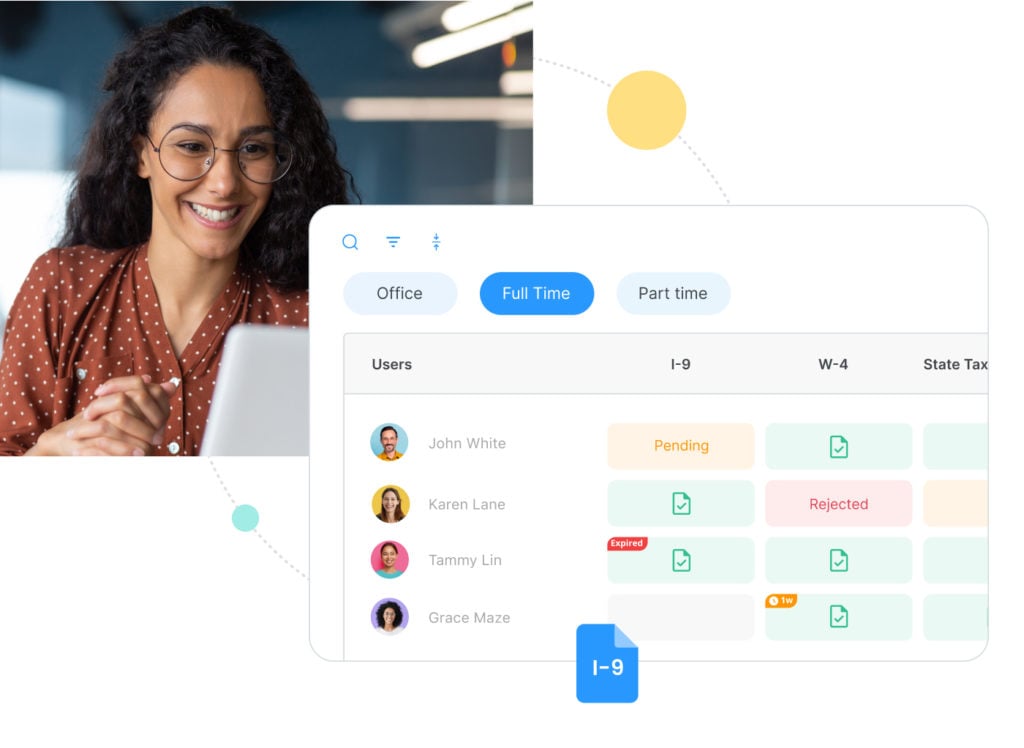
Digital onboarding and training directly from employees’ phones
With Connecteam’s HR management system, employees can complete their onboarding directly from their smartphones. Create onboarding courses for your new hires with quizzes at the end of every section to ensure they retain the information.
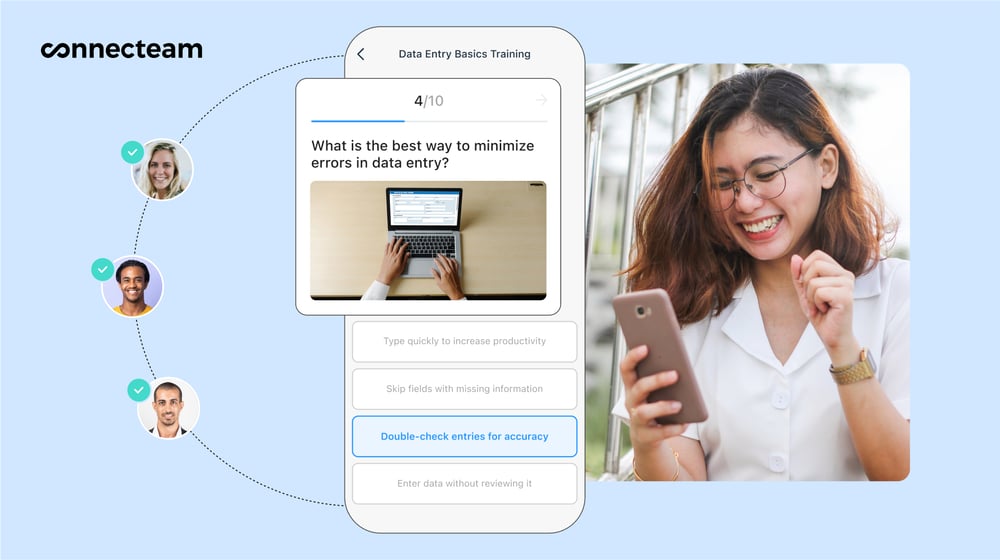
Online employee training is also more convenient and engaging. All training materials are always accessible from the user-friendly app and can be divided into bite-size sections, making the content more digestible and easier to retain. You can use multiple mediums too, like videos and colorful slideshows.
Managers can also track progress and even collect employee feedback at the end of training using the forms feature.
Boost employee morale with recognition and rewards
This HRIS software makes employee recognition simple with rewards and recognition features. Use the company newsfeed to spotlight exceptional employees, wish them happy birthday, or congratulate them on a promotion. You can even give employees digital badges of success or reward them with tokens they can redeem for gift cards to their favorite stores and restaurants.
Simplify communication with in-app chat and company directory
From day one on the job, all employees have access to in-app chat and the employee directory. Employees and managers can instantly message each other privately or via group chat with the chat feature, reducing communication roadblocks.

The directory contains all employee contact information–all searchable by name, department, position, or location, so everyone is always easy to reach.
Time-off management is made easier
With Connecteam, you can manage all time-off tasks using a single app with the time-off feature: view leave and time-off requests from the admin dashboard, communicate time-off policies, track balances, and avoid scheduling and time-tracking errors.
Seamless integration with payroll software
Employee hours are automatically recorded onto digital timesheets, which can be exported into payroll software, like RUN Powered by ADP®, QuickBooks, and Gusto. This makes the entire payroll process much quicker and more efficient.
Connecteam integrates with:
- Quickbooks
- Gusto
- Paychex
- Xero
- Zapier
- RUN Powered by ADP®
And so much more
In addition to being a completely customizable system to manage all HR functions, Connecteam also offers tools to manage your entire workforce directly from your phone. The user-friendly interface and excellent customer support make it easy to quickly get Connecteam up and running for your business.
Connecteam is the most affordable HRMS on the market. The paid plan starts at just $29 per month for up to 30 users, and small businesses with fewer than 10 users can access the app completely free.
When we implemented Connecteam, the biggest thing for me as a company owner was actually taking back control of my own company.
Connecteam also offers a free for life plan – Try Connecteam here!
Key Features
Pros
Useful for small businesses and large corporations
User information is kept safe and secure
Intuitive and easy to use
Very responsive customer support
Cons
Needs internet or wifi access to work
Pricing
Free-for-life plan availablePremium plans start at $29/month for 30 users
14-day free trial, no credit card required
Start your free trial -
Namely — Good for midsized businesses
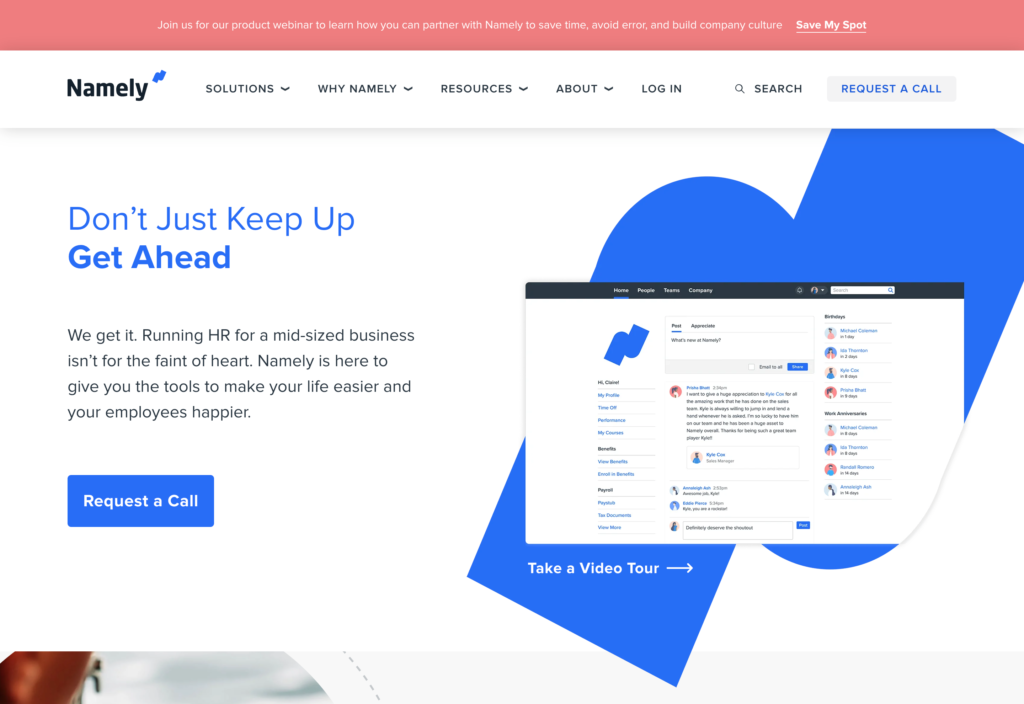
Namely is one of the best HRIS systems on the market and aims to help mid-sized businesses manage all of their HR data in one place with personalized service.
This HRIS systems software allows you to manage categories of general HR matters, talent, benefits administration, payroll and time, and compliance. As part of these categories, you can store all employee data and have your employees and HR professionals make changes on their own through a self-service portal. You can also track onboarding, set goals, manage performance, process payroll, and more.
Namely also includes analytical tools to review and export data in the system. However, their website lacks pricing transparency and requires you to request a call or demo to receive a quote.
Key Features
- Records system
- Time and attendance tracking
- Applicant tracking
- Point-in-time reporting
Pros
- Intuitive user experience
- Good reporting options
Cons
- Lacks pricing transparency
- Limited data import options
Pricing
Contact vendor for price Trial: No Free Plan: No
-

BambooHR — Good for compensation management

With this HRIS software, managers can store and track all employee records in one place. BambooHR also offers businesses time and attendance tracking, performance management, and payroll services. It also comes with customizable surveys so managers can gather team feedback from anywhere.
The app has self-service options for employees to access their personal information, review benefits, complete training, and provide peer feedback. Employees are able to calculate and request time off, too.
Another great feature is BambooHR’s applicant tracking system and recruitment tools. However, it’s worth noting that hiring, training, reporting, and other essential features are not available on the basic plan.
Key Features
- Background Checks
- Candidate Tracking
- Job Posting
- Self Service Portal
Pros
- Good customer support
- Simple employee adaptation
Cons
- Not as many features as other HR software, according to reviews
- Reporting features could be more advanced
Pricing
Contact vendor for price Trial: Yes — 14 days Free Plan: No
-
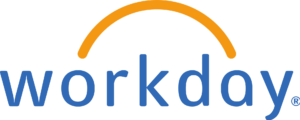
Workday — Good for workforce optimization
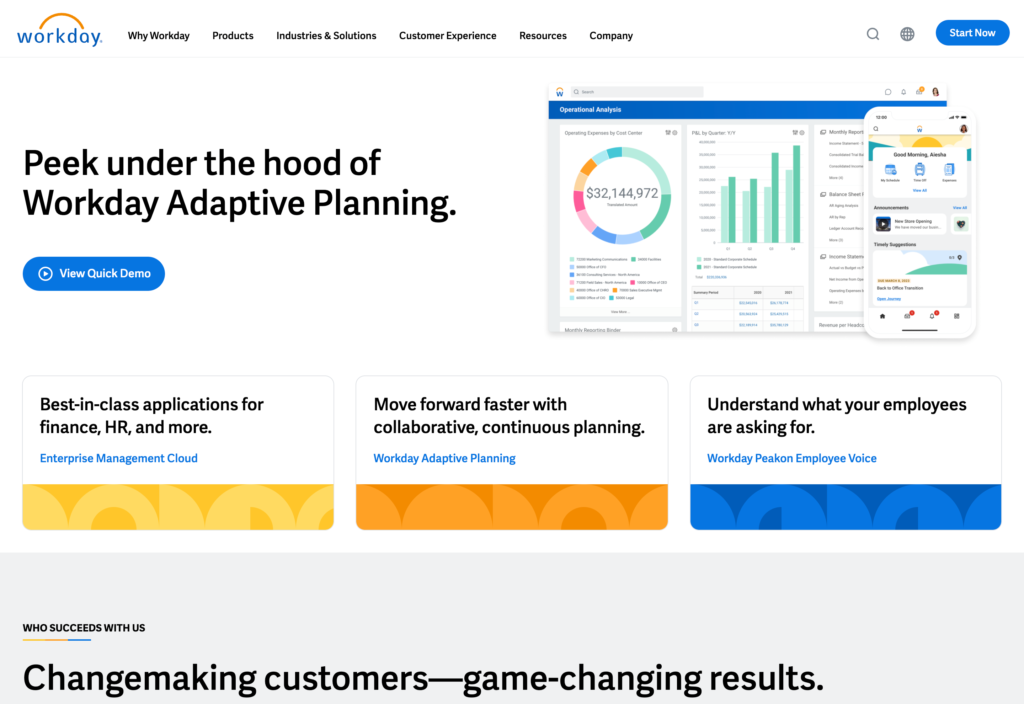
Workday is a complete HRIS system that can help you manage all aspects of human resources management and payroll. One of its best features is the employee feedback feature, which allows you to collect employee feedback and then analyze it. Then, the system sends you insights immediately so you can quickly know how employees feel about whatever process you want to gauge. Workday also has AI-powered decision support to help you deliver better employee experiences, improve operational efficiencies, and provide insights for faster decision-making.
Key Features
- AI-powered decision support
- Benefits administration
- Payroll
- Time & attendance management
Pros
- Good analytics overview
- Engaging user interface
Cons
- Implementation takes a long time
- Hard to navigate
Pricing
Contact vendor for price Trial: No Free Plan: No
-
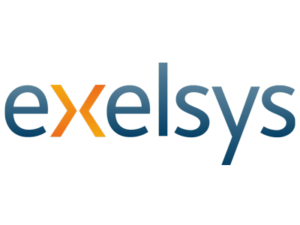
Exelsys — Good for recruiting new employees
Available on
- Web
- iOS
- Android
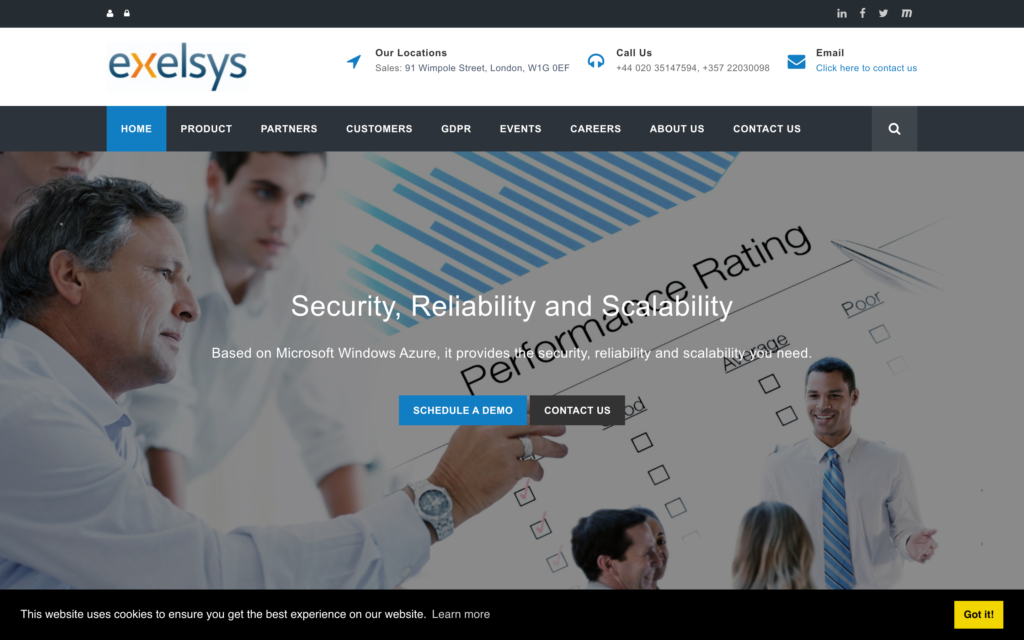
With Exelsys, you can automate and streamline HR processes and administrative tasks, including employee information, recruitment, performance, and payroll management. Human resources managers can upload and fill out documents, track applicant data, set and monitor goals, and sync different payroll systems.
Key Features
- Applicant data tracking
- Absence management
- Goal management
- Appraisal reviews
Pros
- Easy to use
- Intuitive user experience
Cons
- Reporting feature needs improvements
- Unengaging user interface
Pricing
Pricing is not publicly available Trial: No Free Plan: No
-

Oyster HR — Good for companies with employees in multiple countries
Available on
- Web
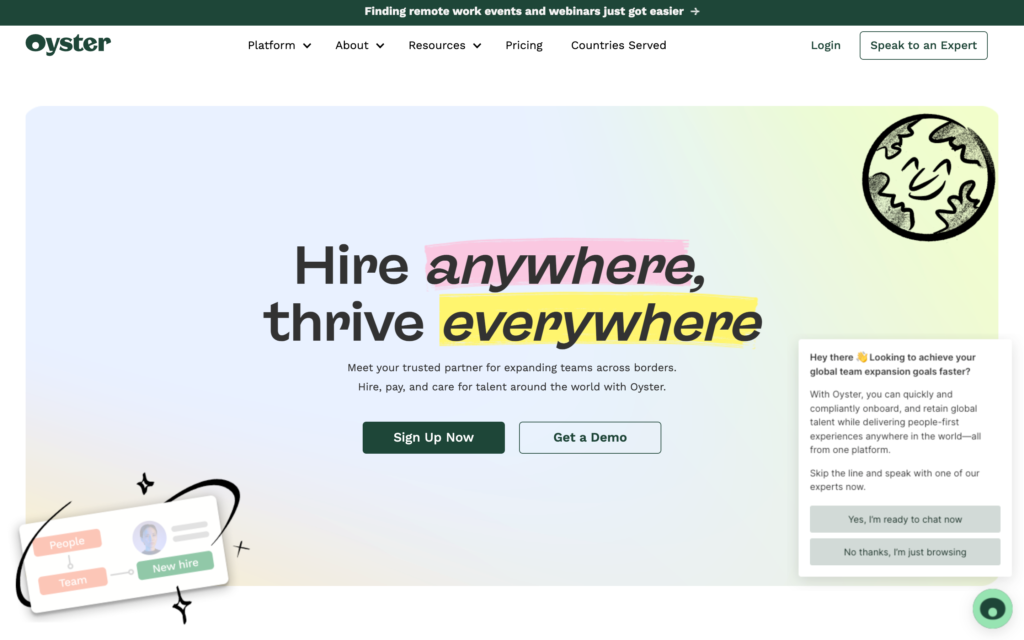
Oyster HR makes it easy for companies to compliantly hire remote full-time and contracted employees, no matter where they’re located in the world.
This top HRIS system offers capabilities to manage and generate locally-compliant contracts in over 180 countries, process fully-compliant payroll, and administer local employee benefits and rewards. It also includes tools to calculate the total cost of employment and time zone crossovers.
Another feature we like is the new employment calculator, which allows you to get a complete understanding of how much it will cost you to hire a new employee. Once hired, you can create individualized onboarding and training materials and check in with your new employees as often as needed.Key Features
- Global employment capabilities
- Localized benefits & rewards
- Multi-country payroll
- Global contactors
Pros
- Easy to set up
- Intuitive user experience
Cons
- Extremely expensive
- Poor customer service
Pricing
Starts at $399/user/month Trial: Yes Free Plan: Yes
-

IntelliHR — Good for businesses using multiple HR software
Available on
- Web
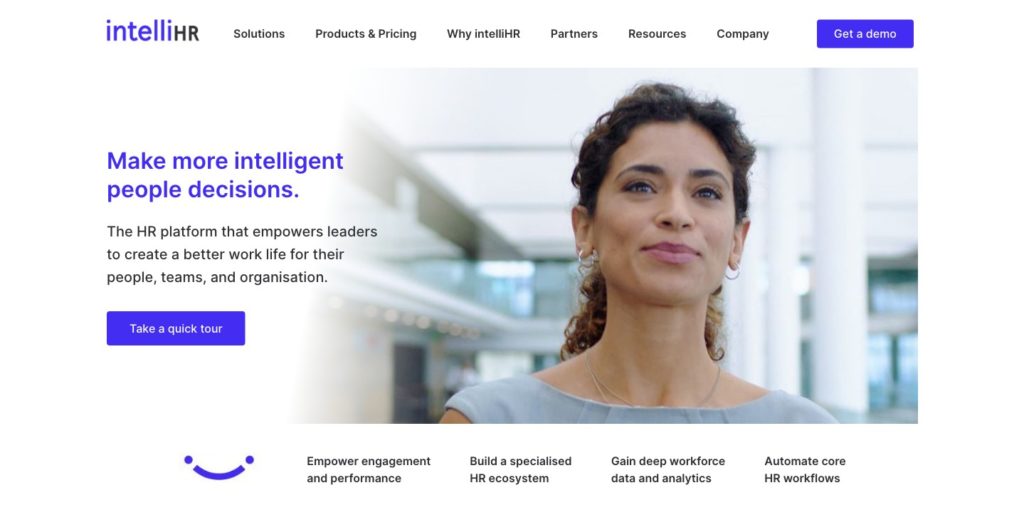
Companies can manage employee performance, create business strategies, and enhance strategic decision-making with analytics using IntelliHR.
This HRIS system allows you to centralize HR data and automate processes, manage your teams and review their performance, give feedback, deliver onboarding and automated workflows for new hires, manage compliance requirements, and view analytics.However, one of the downsides of IntelliHR is that it relies on integrations for many features, including payroll, recruitment, and training, which will likely require you to purchase other software.
Key Features
- Onboarding and training
- Performance reviews
- Engagement analytics
- Survival analysis
Pros
- Engaging user interface
- User-friendly
Cons
- Not budget-friendly
- Lacks data import options
Pricing
Starts at $4/user/month Trial: No Free Plan: No
-
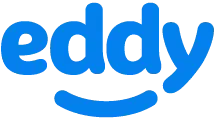
Eddy — Good for local businesses with frontline workers
Available on
- Web
- Windows
- Mac
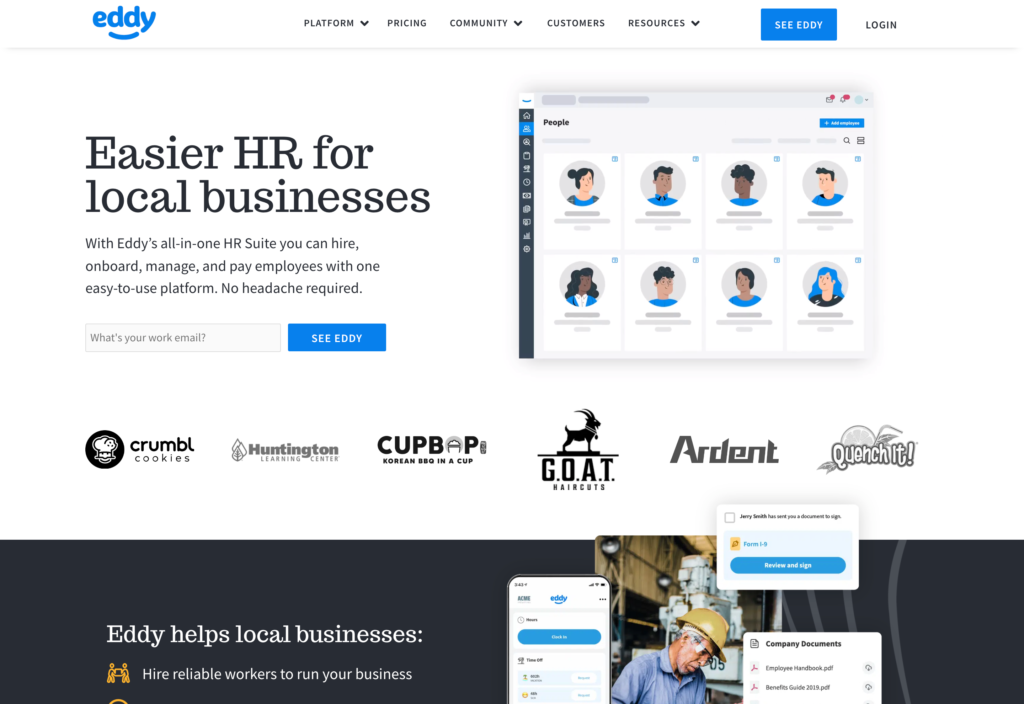
This fully integrated HRIS and payroll software allows you to automate and manage your HR tasks in one place. Eddy includes features specifically for recruiting and onboarding new hires, managing teams, and conducting payroll for your workforce.
As part of these four categories, you can post jobs and track candidates, create onboarding processes, manage important documents and employee profiles, create custom PTO policies and process requests, track employee work hours, and manage payroll.
Eddy is great specifically for remote teams and frontline workers because it includes features like mobile time tracking, online document storage, and electronic signatures.
Key Features
- Remote onboarding
- Document storage
- Mobile time tracking
- Employee profiles and directory
Pros
- Good customer support
- Clean user interface
Cons
- Hard to set up
- Unintuitive user experience
Pricing
Starts at $50/month + $4/user/month Trial: No Free Plan: No
-
Kallidus — Good for remote onboarding and training
Available on
- Web
- iOS
- Android
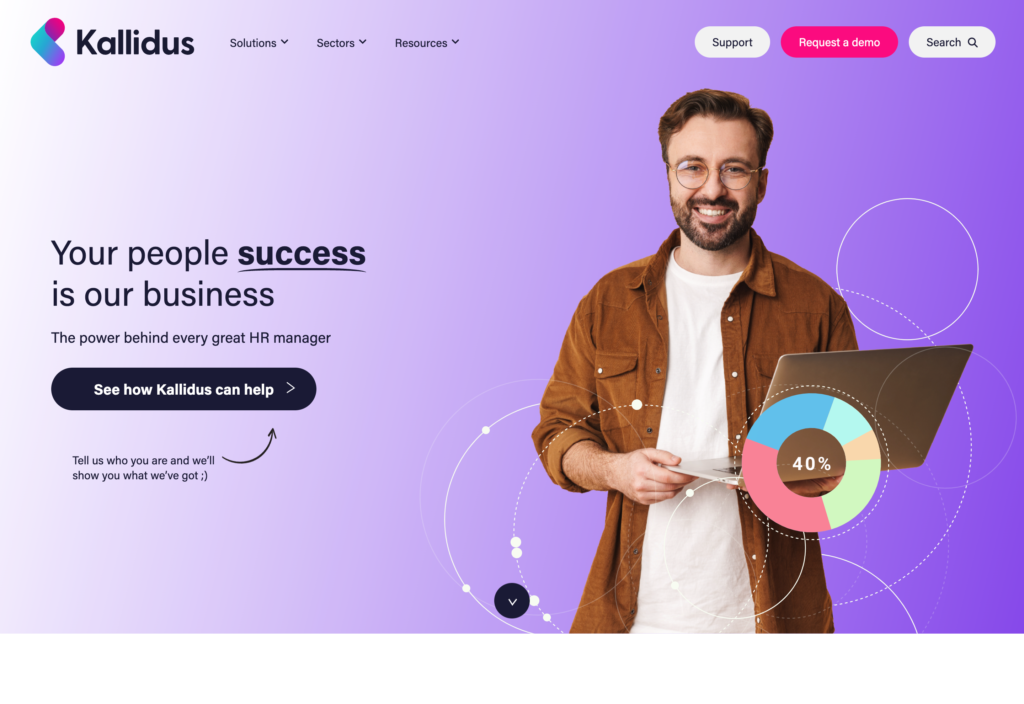
With Kallidus’ HRIS solution, you can create completely customized onboarding and training materials. Then, specify to your staff which training courses are mandatory and which ones are optional, and they can complete them from desktop, mobile phone, or tablet. Training can be linked to team KPIs, too. Managers also have access controls so they can give permissions only to workers that need specific training.
Kallidus also includes employee lifecycle management features to support workers throughout their entire time with a business. This includes performance evaluations, surveys, employee timelines, and offboarding tools.
Key Features
- Customized training
- Employee lifecycle management
- eLearning
- Compliance tools
Pros
- Very intuitive user interface
- Good customer service
Cons
- Prone to freezing and bugs
- No payroll tools
Pricing
Contact vendor for price Trial: No Free Plan: No
-
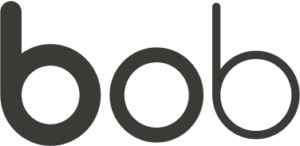
HiBob (bob) — Good for midsized, fast-growing businesses
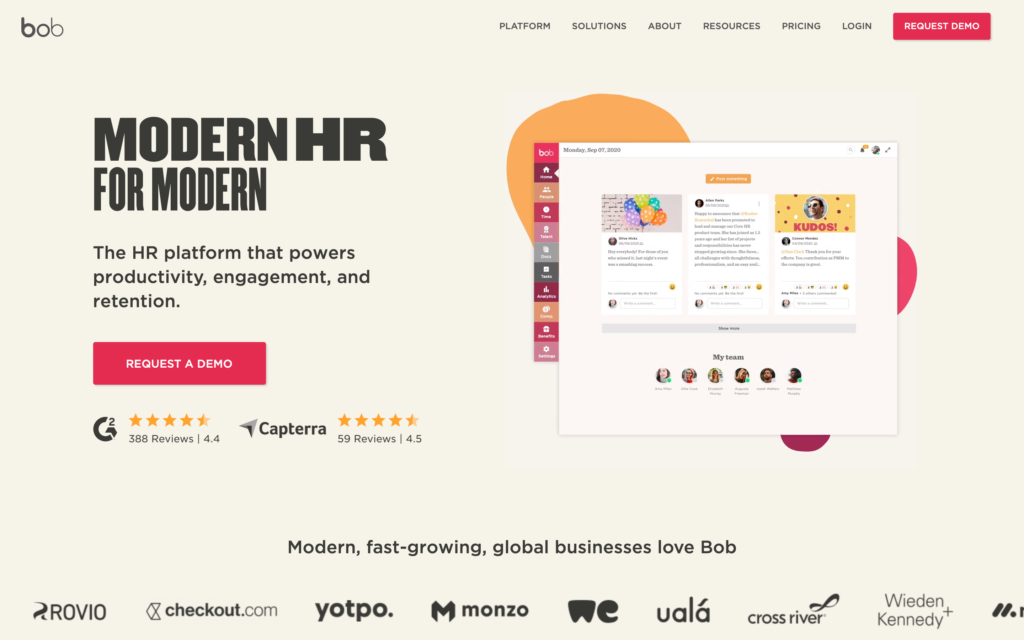
HiBob’s core HR capabilities include time and attendance tracking, maintaining company culture, managing employee performance, and automating workflows. This powerful HRIS software also allows you to automate approval cycles, manage customized onboarding processes, create company directories, manage payroll and benefits, automate paperwork, and view real-time data and reports.
However, HiBob does not provide all functions within its platform and offers a large number of integrations, including applicant tracking. It’s also worth noting that it doesn’t post pay structure on its website, so you’ll need to contact the sales team for details.
Key Features
- Automated task management
- People analytics
- Workforce planning
- Payroll integrations
Pros
- Company newsfeed simplifies communication
- Receptive of customer feedback
Cons
- Features need further development
- Difficult to customize the app in accordance with company policies
Pricing
Contact vendor for price Trial: No Free Plan: No
-
Homebase — Good for teams with hourly workers

This all-inclusive human resource information system comes with a complete employee scheduler that allows managers to create employee schedules, track workers’ time and location while they’re on the clock, and send automatic shift reminders. Managers can also use Homebase to add notes to shifts with instructions and reminders. It even alerts you when state or federal labor laws change so you can be sure to remain compliant with them.
Homebase includes training tools, an employee time clock, timesheets, payroll integrations, and team communication tools. This HRIS is also a good app to promote and maintain employee happiness because of its easy-to-use interface, simple chat features, and self-service tools.
Key Features
- Labor law compliance notifications
- Job postings
- Applicant tracking
- Time off management
Pros
- Easy to set up
- Scheduling template options
Cons
- Prone to freezing
- Lacks intuitive payroll capabilities
Pricing
Starts at $24.95/location/month Trial: Yes — 14-day Free Plan: Yes — For a single location & up to 20 employees
Compare the Best HRIS Systems
| Topic |
 Start for free
Start for free
|
|

|

|

|

|

|

|
|

|
|
|---|---|---|---|---|---|---|---|---|---|---|---|
| Reviews |
4.8
|
4.2
|
4.6
|
4.4
|
N/A
|
3
|
4.9
|
4.6
|
4.3
|
4.6
|
4.6
|
| Pricing |
Starts at just $29/month for the first 30 users
|
Contact vendor for price
|
Contact vendor for price
|
Contact vendor for price
|
Pricing is not publicly available
|
Starts at $399/user/month
|
Starts at $4/user/month
|
Starts at $50/month + $4/user/month
|
Contact vendor for price
|
Contact vendor for price
|
Starts at $24.95/location/month
|
| Free Trial |
yes
14-day
|
no
|
yes
14 days
|
no
|
no
|
yes
|
no
|
no
|
no
|
no
|
yes
14-day
|
| Free Plan |
yes
Free Up to 10 users
|
no
|
no
|
no
|
no
|
yes
|
no
|
no
|
no
|
no
|
yes
For a single location & up to 20 employees
|
| Use cases |
Best all-in-one HRIS system
|
Good for midsized businesses
|
Good for compensation management
|
Good for workforce optimization
|
Good for recruiting new employees
|
Good for companies with employees in multiple countries
|
Good for businesses using multiple HR software
|
Good for local businesses with frontline workers
|
Good for remote onboarding and training
|
Good for midsized, fast-growing businesses
|
Good for teams with hourly workers
|
| Available on |
Web, iOS, Android
|
Web
|
Web
|
Web, Windows, Mac
|
Web, iOS, Android
|
What is an HRIS system?
A human resource information system is software that allows HR teams to automate and handle HR-related tasks more effectively. Managers and HR leaders can also centralize, manage, track, and assess staff-related data. Features may include: time and attendance tracking, payroll, training and development, performance management, recruitment and onboarding, and payroll and benefits administration.
Based on data collected in HRIS systems, HR teams can make strategic, efficient, and well-informed decisions, which boost the productivity of employees and managers.
How Does an HRIS Work?
A human resource information system integrates different HR processes into centralized software and allows HR staff to streamline organizational tasks and handle employee information. This can include managing time and attendance, payroll, onboarding, documentation, and recruitment.
HRIS software often has a self-service portal where employees can perform different actions, such as updating their personal records, logging work hours, and reviewing their timesheets.
All data is logged within the system and can be exported into reports, reducing manual data entry. The HRIS can then use that data to make better decisions for the company.
Employee documentation, benefits, paid time off, payroll, and the safe storage of staff contact information also help companies remain compliant with local and federal labor laws.
Some HRIS come with an HR mobile app so you can handle HR tasks while on the go.
Benefits of an HRIS
These are some of the reasons you may choose an HRIS and payroll system:
Increased efficiency
By automating HR processes, like payroll, benefits administration, attendance tracking, and recruitment, companies can run more efficiently. This leads to increased productivity.
Streamlined data management
Employee data is all stored in one place, making it easy to access, update, and manage information. This eliminates the need for maintaining multiple spreadsheets or paper files, reducing errors and ensuring data accuracy.
Enhanced reporting and analytics
HRIS systems provide powerful reporting and analytics tools that allow HR teams to generate valuable insights from the data. They can analyze trends, identify potential issues, and make data-driven decisions to improve workforce management.
Improved compliance and accuracy
Organizations can better comply with employment laws and regulations by automating compliance-related tasks and maintaining accurate records.
Better talent management
HRIS software supports performance management and training programs, so businesses can keep better track of employee performance and development.
Employee self-service
Self-service portals for employees allow them to access their personal information, request time off, view pay stubs, and update details. This reduces HR administrative tasks and improves employee satisfaction.
Cost savings
Though there is an initial investment in implementing an HRIS, the long-term cost savings are significant. Automated processes reduce the need for manual labor, paper, and other administrative expenses.
Scalability and flexibility
HRIS and payroll systems can adapt to the changing needs of an organization as it grows. Whether a company expands its workforce or introduces new HR processes, the system can be easily scaled and customized accordingly.
How Much Does an HRIS Cost?
Costs vary per provider and are often dependent on the number of users and the type of feature package. HRIS providers usually charge on a monthly basis with pricing typically ranging from $1 to $15 per employee. Companies that charge per user can get rather expensive if you’re working with a large team.
Connecteam is a more affordable option, with paid plans starting at as little as $29 per month for up to 30 users, plus just $0.50 per additional user per month. Compare that to Novade, where the Lite plan is $24 per user, per month for more than 5 users. For a 35-employee company, Connecteam would cost $32 per month, while Novade Lite would be $720 per month.
Connecteam also offers a Small Business Plan that’s free for life for teams of 10 or fewer people.
FAQs
Different acronyms are used to describe HR software solutions. The three most common terms used are:
- HRIS (Human Resource Information System)
- HCM (Human Capital Management)
- HRMS (Human Resource Management System)
An HRMS (human resource management system) and an HRIS (human resource information system) are both software designed to help manage employee information and other HR-related tasks.
While the terms are sometimes used interchangeably, these are the 3 key differences:
- Integration: HRMI are often integrated with other types of software, such as finance, accounting, and payroll software, while HRIS do not.
- Capabilities: An HRMS has a broader scope of capabilities than an HRIS. Human resource management systems are intended for HR data management along with payroll, benefits, and other related functions. In contrast, an HR data management system focuses exclusively on HR data.
- Customization: An HRMS is more customizable than an HRIS. Human resource management systems usually support growing companies as they hire more employees and need to store more data.
HRIS can be used by any company in any industry. While some argue that HRIS is most suitable for companies with over 50 employees, organizations of different sizes – from small-sized companies to enterprises – can benefit from this type of software.
The Bottom Line On HRIS Tools
The right HRIS will allow you to finally ditch those tedious and time-consuming manual tasks and carry out all of your HR processes on one single platform with complete ease and efficiency.
And the best part is that you can get all the features you need without breaking the bank. Our first choice, Connecteam, for instance, offers an easy-to-use all-in-one human resource information system that will keep you connected with your workforce anywhere and anytime for a fair price.



